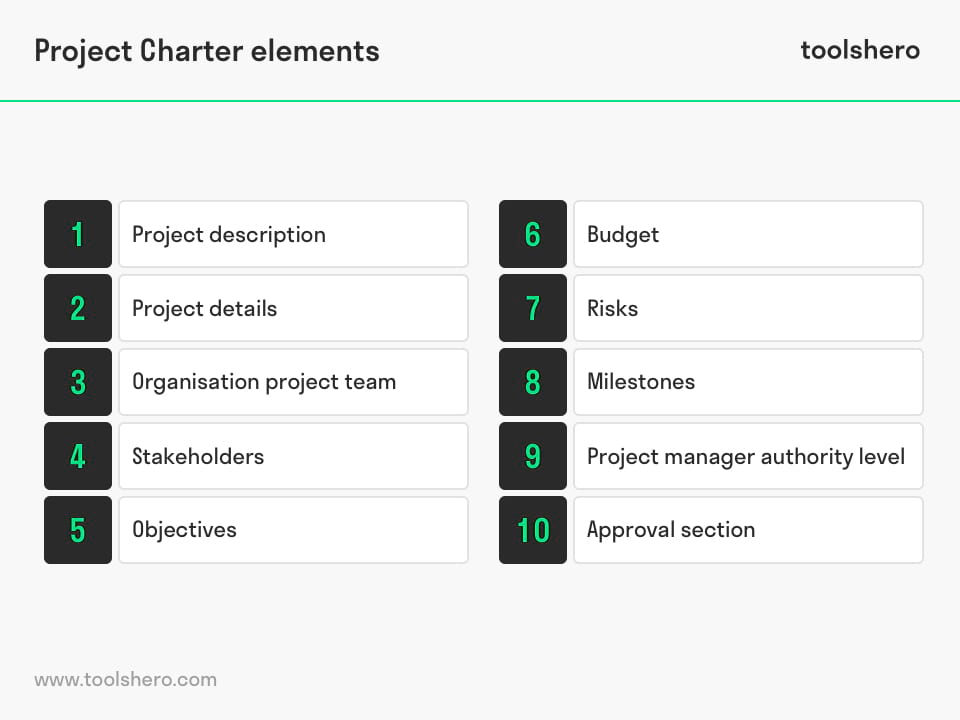Project Charter explained including a template

Project Charter: this article provides a practical explanation of the Project Charter. Next to what it is (definition), highlights this article also important applications this type of document, the 10 elements including an example and a template to get started with your own project. Enjoy reading!
What is a Project Charter?
A Project Charter (PC) refers to a formal, short document that contains the objective statement of a project. This statement describes key project goals, the roles of team members (including responsibilities), and the key stakeholders and their interests.
In addition, the document also includes milestones, budgets, the project timeline, and potential risks. Many organisations consider the charter an essential part of project planning and use it as a way of authorizing the project.
However, it is not the same as a project plan. The latter elaborates on the details of individual tasks within a project.
The definition of Project Charter
The importance of the project charter has increased in recent years. The most recent edition of A Guide to the Project Management Body of Knowledge (PMBOK) added a completely new process: ‘develop project charter’. This has made the document all the more popular. PMBOK defines as follows:
‘A project charter is a formally issued document by the project initiator or sponsor that formally authorises the existence of a project and empowers the project manager to apply organisational resources to project activities.’
A good PC should:
- Contain the essence of the project
- Ensure all stakeholders and sponsors agree on matters
- Ensure a shared understanding of the project
- Act as a contract between the project team, the sponsor, and the main stakeholders
- Help get project sponsor approval when buy-in is yet to take place
Important applications of a project charter
The three most important applications are:
- To authorise a project. Project charters all have a similar format, making it possible to compare different projects based on Return on Investment.
- The project charter acts as the primary sales document for the project.
- The project charter acts as a central focus point throughout the project (Scope Control).
Who is responsible for creating the project charter?
A common misconception is that the sponsor of the project is wholly responsible for creating the charter. In reality, however, sponsors rarely have time to work on one. For this reason, they often delegate this work to another person. This is most often the project manager. Although it is ultimately the sponsor who authorises the completed PC.
In addition to the above matters, the project charter also establishes the project manager’s responsibilities and authority. This helps keep the team on the same page before the project even starts.
10 elements project charter with example
Below is a practical explanation of all elements of a project charter. If you are a Toolshero member you can also download a project charter template. This includes all the components you need, allowing you to immediately get started with creating your personal project charter.

figure 1 – the 10 elements of a Project Charter
1. Project description
The first part of a PC provides basic information such as:
- Project name
- Date on which the document was created
- Author
- Project sponsors
- Project manager
In addition, the goal of the project is also explained. Usually a reference is made to a business case or the contract that forms the basis of the project.
Alternatively, a description may be made of why the implementation of the project is important to the organisation. Several questions the author of the document should consider include:
- Does this project solve an organisational problem?
- Is the project related to a new trend?
- Does the project support the overall strategy of the organisation?
2. Project details
The second element is a slightly more detailed project description that includes the mission and scope of the project. The exact goal of the project will be addressed later, but includes at least the following in this section:
- List some of the project objectives. Use SMART goals for this.
- Outline the project’s formal boundaries by describing how it can change the business.
- Describe all products have the project will eventually produce.
Once these components have been included in the project charter, one can move on to the following.
3. Organisation project team
In this section, explain who is working on the project, who is overseeing the project and group, and include an overview of the roles of the different team members. Keep it short and sweet. Detailed job descriptions will be included in the later project plan.
Use a project organisation chart that reflects the structure of an organisation and the relationships between everyone involved in the project.
4. Stakeholders
In addition to the team members, the project manager and sponsor, there are also other stakeholders. Stakeholder management is an essential part of project planning. In this section, provide a list of people and departments involved in the project. Do not go too deeply into the core of each task in the project, but instead address general roles and involvements of others. When creating the list, also consider:
- Main project managers
- Partners
- Customers
- Outsourced employees
5. Objectives
This section answers the following question: ‘How do we know when the project is ready?’
This section includes the project expectations, and how the project team knows whether they have been realised. Also note who will be responsible for authorising that the project goal has been achieved. This prevents problems at the end of the project if no one is willing to sign off the work as completed. Include the following matters:
- Success criteria. Define the project successes and list the Critical Success Factors.
- Important requirements or deliverables. Describe key stakeholder requirements and key project results.
6. Budget
At the time the project charter is created, not all details about the project may be known yet. In other words, a complete and accurate project budget cannot be compiled yet. For this reason, use all the above information to make a rough outline of how much it costs to complete the project within the agreed time. The actual costs may vary. Take budget restrictions or an overview of the expected potential costs into account.
7. Risks
Even the most carefully planned project may end up in trouble. This part of the project charter includes an early version of the risk log.
In this log, document all risks currently identified, so that the management team and sponsors can see what could potentially impact the project in the future.
A risk is the probability of an event or condition that may affect the project. Not all risks are negative. If so, they are more likely to be referred to as opportunities, however.
8. Milestones
Include high-level milestones in this section of the PC. It is possible that not all information may be known at present, but at least write down the estimated start and end date of the project. Also include drop-dead dates and add the milestones to an organised Gantt chart.
Instead of a Gantt chart, you may also use a timeline, calendar or other document that visualises project planning with details about each milestone or phase.
9. Project manager authority level
Unless the project manager’s powers are clearly established elsewhere, it is worth using this section of the project charter to record what the project manager can do without a senior’s approval. In general, this section relates to established tolerance levels with regard to the budget and time span.
For example: the project manager has a tolerance of 15% with regard to the budget, and a tolerance of 8% with regard to the time schedule. Any deviation outside of these limits must be reported to and approved by the project sponsor/senior.
Furthermore, this section can be extended by specifying the powers that the project manager has over hiring and firing the employees in the project team.
10. Approval section
The final part of the project charter is the approval section. The project manager and project sponsor must date and sign the document. It does not matter whether this is done digitally or on paper. In both cases, keep a copy in case it needs to be consulted later again.
The Project Charter is not always just a single document
Ideally, a Project Charter is a single document with references to other documents that address business needs, planning, and other important aspects.
If the sponsor has approved project-related documents, and permission has been granted, then the collection of approved documents actually constitutes the charter.
Even if these documents do not explicitly refer to each other, the collection can be considered a charter. This makes it apparent that it very much depends on the goal of the project whether or not a standard format charter should be created.
For many companies that carry out projects, a work order is considered an important part of the charter. This work order gives specific people authority over organisational resources to carry out the project.
Multiple charters for a single project
A typical project in the corporate world will have multiple charters. A good project manager understands the scope of the current charter, and has the ability to look ahead to create charters for subsequent stages.
For example, according to PMBOK, each project goes through several phases, and each of these phases has a charter.
Many project managers struggle to establish the original charter, but identifying charters for each successive stage is even more difficult. This is because the transition is often subtle.
Hierarchy
Some projects go from phase to phase without this being noticed. The customer or sponsor has little insight into the phases and activities of the project, so it is difficult to authorise each phase.
However, the sponsor has given the project manager authority over the internal project activities, including the transition from one phase to another. So, the project manager has been given the authority to authorise each phase within the project itself.
Project Communication Plan (PCP)
Although it is not a fixed part of the charter, project communication is a simple tool that can be used during the first charter phase.
A communication plan facilitates effective communication between the sponsor, customer, team and other stakeholders. It contains clear guidelines for how information is shared, and who is responsible for communication in all aspects thereof.
A communication plan plays an important role in any project because:
- It provides a written overview that everyone can access
- It sets clear expectations about how and when updates are shared with different parties
- It increases the visibility of the project and its status
- It increases the productivity of team meetings
- It ensures that the project activities remain in line with the objectives
Make the charter visually appealing
Project stakeholders will read the project charter at least once, even it only contains text. However, use images or other design elements to make the Project Charter look more appealing and easy to understand, and to make it easier for people to take a look at it at a later stage.
Clearly divide different sections of the Project Charter with compartments or accentuated headers for better readability.
Subsequently discover which elements of the charter are easy to summarise visually. Especially the milestones section is suitable for visualising, with for example a timeline or Gantt chart.
Project charter template
Now that you’ve read about the project charter, you bring bring knowledge into practice. Download the project charter template in which the above elements are included to get started with your own project.
Download the Project Charter template
This template is exclusively for our paying Toolshero members. Click here to see if a membership is something for you!Now it’s your turn
What do you think? Are you familiar with the explanation of the project charter? Do you recognise similarities compared to the Project Initiation Document (PID)? Have you ever participated in a project team? Did you use a project charter at the time? What else do you believe is important to include in such a document? Do you have any other tips or additional comments?
Share your experience and knowledge in the comments box below.
More information
- McKeever, C. (2006). The Project Charter–Blueprint for Success. CrossTalk: The Journal of Defense Software Engineering, 19.
- Kerzner, H. (2017). Project management metrics, KPIs, and dashboards: a guide to measuring and monitoring project performance. John Wiley & Sons.
- Ruecker, S., & Radzikowska, M. (2008, February). The iterative design of a project charter for interdisciplinary research. In Proceedings of the 7th ACM conference on Designing interactive systems (pp. 288-294).
- Wideman, R. M. (2002). Comparing PRINCE2® with PMBoK®. AEW Services, Vancouver, BC, Canada, 13-16.
How to cite this article:
Janse, B. (2020). Project Charter. Retrieved [insert date] from Toolshero: https://www.toolshero.com/project-management/project-charter/
Original publication date: 06/06/2020 | Last update: 03/14/2023
Add a link to this page on your website:
<a href=”https://www.toolshero.com/project-management/project-charter/”>Toolshero: Project Charter</a>












